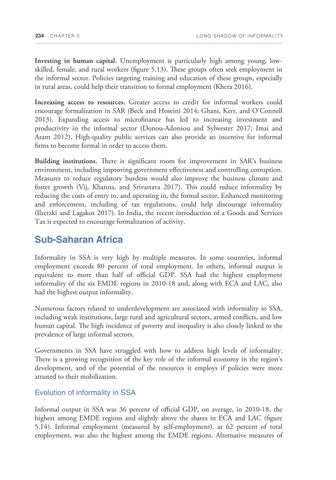234
C H A P T ER 5
L O NG S HA D O W O F I N F O R MA L I T Y
Investing in human capital. Unemployment is particularly high among young, lowskilled, female, and rural workers (figure 5.13). These groups often seek employment in the informal sector. Policies targeting training and education of these groups, especially in rural areas, could help their transition to formal employment (Khera 2016). Increasing access to resources. Greater access to credit for informal workers could encourage formalization in SAR (Beck and Hoseini 2014; Ghani, Kerr, and O’Connell 2013). Expanding access to microfinance has led to increasing investment and productivity in the informal sector (Donou-Adonsou and Sylwester 2017; Imai and Azam 2012). High-quality public services can also provide an incentive for informal firms to become formal in order to access them. Building institutions. There is significant room for improvement in SAR’s business environment, including improving government effectiveness and controlling corruption. Measures to reduce regulatory burdens would also improve the business climate and foster growth (Vij, Khanna, and Srivastava 2017). This could reduce informality by reducing the costs of entry to, and operating in, the formal sector. Enhanced monitoring and enforcement, including of tax regulations, could help discourage informality (Ilzetzki and Lagakos 2017). In India, the recent introduction of a Goods and Services Tax is expected to encourage formalization of activity.
Sub-Saharan Africa Informality in SSA is very high by multiple measures. In some countries, informal employment exceeds 80 percent of total employment. In others, informal output is equivalent to more than half of official GDP. SSA had the highest employment informality of the six EMDE regions in 2010-18 and, along with ECA and LAC, also had the highest output informality. Numerous factors related to underdevelopment are associated with informality in SSA, including weak institutions, large rural and agricultural sectors, armed conflicts, and low human capital. The high incidence of poverty and inequality is also closely linked to the prevalence of large informal sectors. Governments in SSA have struggled with how to address high levels of informality. There is a growing recognition of the key role of the informal economy in the region’s development, and of the potential of the resources it employs if policies were more attuned to their mobilization.
Evolution of informality in SSA Informal output in SSA was 36 percent of official GDP, on average, in 2010-18, the highest among EMDE regions and slightly above the shares in ECA and LAC (figure 5.14). Informal employment (measured by self-employment), at 62 percent of total employment, was also the highest among the EMDE regions. Alternative measures of
